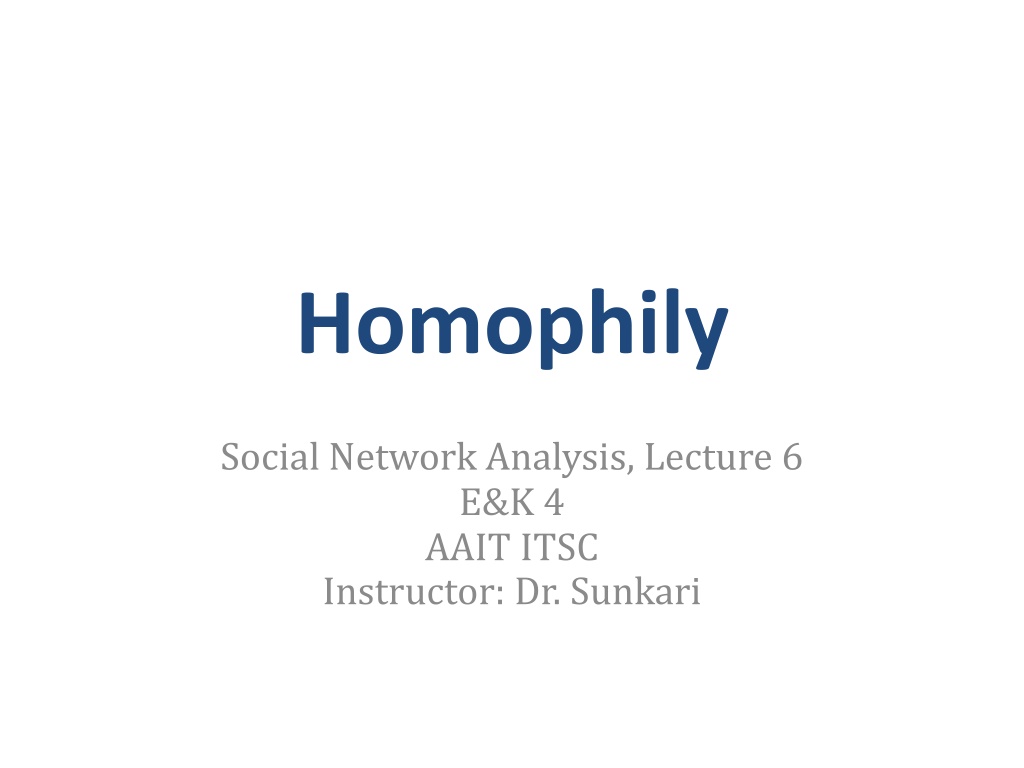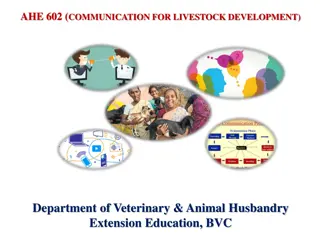
Understanding Homophily in Social Network Analysis
Explore the concept of homophily in social network analysis, where individuals tend to associate with others who are similar to them. Learn about measuring homophily, examples like childhood friendships, and models like the Schelling Model for spatial segregation.
Download Presentation

Please find below an Image/Link to download the presentation.
The content on the website is provided AS IS for your information and personal use only. It may not be sold, licensed, or shared on other websites without obtaining consent from the author. If you encounter any issues during the download, it is possible that the publisher has removed the file from their server.
You are allowed to download the files provided on this website for personal or commercial use, subject to the condition that they are used lawfully. All files are the property of their respective owners.
The content on the website is provided AS IS for your information and personal use only. It may not be sold, licensed, or shared on other websites without obtaining consent from the author.
E N D
Presentation Transcript
Homophily Social Network Analysis, Lecture 6 E&K 4 AAIT ITSC Instructor: Dr. Sunkari
Today Homophily! Before: Networks as graphs, Graph theory, Random graphs Today: Homophily Mechanisms Affiliation
Review: Community structure defined on nodes/vertices Dfn: A community structure, , is a collection of disjoint subsets of V (i.e., a partition) whose union is V.
Grouping by similarity Homophily: we tend to be similar to our friends Plato: similarity begets friendship Aristotle: people love those who are like themselves Intrinsic causes, e.g., triadic closure Extrinsic causes, e.g., affiliation
Measuring homophily Pick a characteristic, e.g., ethnicity Does that kind of similarity matter? links more likely than random? Possible results: Not significant Homophily (signif. more likely links) Inverse homophily (signif. less likely)
Example: Childhood friendships Edges: P(M:M edge) = p2 P(F:F edge) = q2 P(M:F edge) = 2pq Test: if heterogeneous edges are significantly less than 2pq, we have homophily! = male, proportion p = female, proportion q
INDIVIDUAL EXERCISE: Does this graph show homophily by gender? = male, proportion p = female, proportion q
Schelling Model MODELOF SPATIAL SEGREGATION
Schelling Model (1972, 1978) Simpl. 1: people=agents in 2 groups Simpl. 2: space=grid (8 neighbors) Simpl. 3: time in rounds Homophily constraint Agents need threshold in-group neighbors Else discontent will move in next round * models are always wrong, but sometimes they can be useful 1 4 6 2 3 5 8 7
Local homophily Global effect 150x150 grid, 100k blue, 100k red, Threshold = 3
Local homophily Global effect 150x150 grid, 100k blue, 100k red, Threshold = 4 Individual desires for homophily have global effect!
GROUP DISCUSSION: Is there homophily because (a) people form friendships with those like them? (b) people change & become like those around them? selection socialization/social influence
Selection v. Social Influence Selecting similar friends Characteristics shape network Intentional: e.g., at a social gathering Systemic: e.g., physical neighborhood Socialization/social influence Network shapes characteristics Nodes are mutable (changeable)
Whats at play in Homophily? Nuanced unfolding over time, which characteristic, etc. How to study this? Longitudinal studies! How did behavior change before/after joining a group as neighbors behavior changed
Example: Homophily & Health? Obesity study 12,000 people, 32 year Obese vs. non-Obese clusters (homophily!) Hypotheses for cause Selection: friendships form between similar obesity status Socialization: changes in obesity status influence friends obesity status Confounding: Homophily explained by other characteristics (Christakis & Fowler 2007)
Example: Wikipedia editors Similarity: overlap in editing topics (y- axis) Time 0: editors message each other
GROUP DISCUSSION: Situation: You re a public health officer who notes that the use of illegal drugs has increased among some clusters of people (that exhibit homophily) in your area. So you design a health intervention to stop the use of illegal drugs. Because of your limited resources, you re directly interacting with relatively few people, then hoping for those people to change their behavior and then be change agents. Question: Is the health intervention more likely to be successful if the homophily of drug users is based on (a) Selection (b) Socialization Why?
Extrinsic node properties Foci Intrinsic (to graph) only incomplete picture! Foci (focal points of activity) are social, psychological, legal, or physical entit[ies] around which joint activities are organized Not on typical Social Network graph Subsets of V Many/overlapping possible!
Affiliation networks G=(V1, V2, E), where E=(v1, v2) Bipartitegraphs: only connections across 2 types of nodes nodes (here: people) foci (here: company board of directors) What about node-node links? member-of
Social-Affiliation Networks Affiliation networks: had 2 types of nodes Social-Affiliation networks: also 2 types of edges
3 types of Closure Triadic closure: person => person:person Focal closure: focus => person:person Membership closure: person => focus:person

